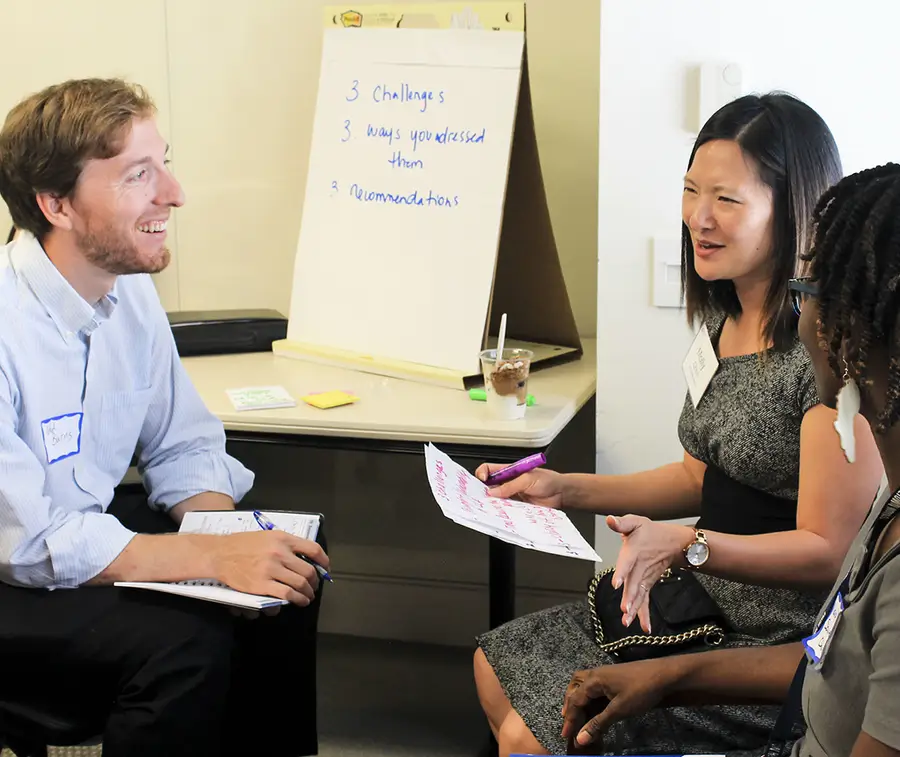We have all been there… that place where we are struggling to “actively” learn, to do more than just report on lessons learned which often end up tucked away at the end of a report, never to be acted upon.
Finding the most effective way(s) to institutionalize learning plans is an extremely difficult task. This process becomes even trickier when you start to think about embedding a culture of learning beyond your immediate team, to the organizational or even at a global level.
Learning specialists, like myself, are continuously acting as facilitators of learning, helping to make a value proposition clear for individuals and teams to think about learning beyond those boundaries to who else might benefit.
As part of the Policy & Learning Working Group at the Society for International Development- Washington (SID-W), we are working to ensure lessons learned are available at the right time to those individuals and teams who need them to inform their next steps.
I see a clear consensus emerging. Shifting the focus to the people involved—and specifically to their individual needs and motivations—has the potential to put documenting and sharing what we learn closer to the top of the ‘to-do’ list, and ensures knowledge and lessons learned reach those who need them.
Planning for a Culture of Learning with Agility and Engagement in Mind
Two critical concepts—AGILITY and ENGAGEMENT—will allow you to create synergies between organizational plans for learning and individual motivations and needs. I elaborate below on how these ideas are mutually reinforcing and provide some practical suggestions you can implement today.
Systems and processes for learning need to be adaptable and flexible. Recognizing that we cannot plan for when learning will happen or when (or where) it will be needed, we need to be flexible. Because learning is non-linear, it requires multiple entry points and modalities. Letting individuals make their own mental models around an issue and follow where that track leads is critical to creating space for adaptation.
Giving individuals and teams more ownership and options around how and when they can collaborate and learn from each other also increases engagement: people are more likely to see this as something they get to do, rather than something they must do.

To reinforce adaptability and engagement, you can offer teams more facilitated conversations. Facilitated conversations allow individuals to capture and share information, enabling peer-to-peer and ‘just in time’ learning. They also make it easier to mine, or search, past discussions so that learning doesn’t require finding the specific individual who experienced the success or failure.
An emphasis on conversation and connection does not negate the desire or need for more formal or tangible products (e.g., policy papers, contract deliverables, conference presentations) but, instead, suggests that the development of formal products should be driven by the individual or team involved rather than considered a standard output of a learning system.
Practical Ideas for Building Engagement and Increasing Agility in Plans for Learning
- Try a Learning (Design) Sprint
The ‘sprint’ methodology comes from the technology industry’s agile development model and is also used in teacher development. This creates time-bound collaboration exercises where a team works together to tackle a particular challenge, or to find a way to reach a specific goal or milestone. At the end of the sprint, the team reviews their progress, lays out successes and challenges, and determines next steps. The process allows for quick iteration to solve difficult problems while simultaneously providing a team building opportunity.
- Create an Ongoing LIVE Discussion Space
Setting up online platforms, such as Teams, Yammer, or WhatsApp, as a dedicated space for discussion allows your team to stay connected, share ideas, and ask questions based on their individual needs and timelines.
- Engage your Team in Some Creative Destruction
Use the Liberating Structures facilitation methodology TRIZ to create space for innovation and eliminate behaviors that could limit success. Using this methodology allows your team to vent frustrations and even discuss taboo topics in a safe and solution-oriented conversation. TRIZ guides a team through first identifying a worst possible or unwanted outcome, defining the behaviors associated with that unwanted outcome, examining whether they currently exhibit any of these “negative” behaviors, and then developing an action plan to stop those behaviors that are preventing their desired outcome.
Sound interesting? You can learn more about TRIZ and other Liberating Structures techniques at liberatingstructures.com.
- Embed Space for Learning into Routine Activities
By providing space and a budget for individuals and teams to reflect on what is working (or not working) we not only emphasize the value of taking time to embed space for learning in routine activities, but also create a habit around it that makes learning seem less effortful.
Big learning events are important—such as quarterly or annual Pause and Reflect sessions—as they allow the client or external stakeholder groups to stay connected and provide input. But equally important, and perhaps more valuable to the team’s embracing a culture of learning, are smaller moments built into routine activities and documented with meeting minutes, or other records, that can be searched or mined later whenever someone needs that information.
Learn More: Integrated Learning Solutions | RTI
